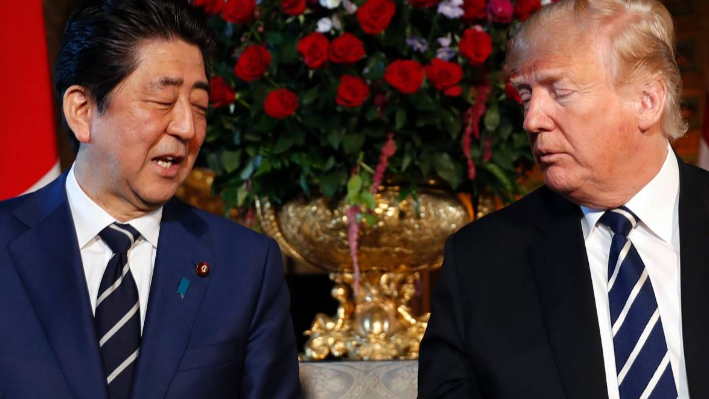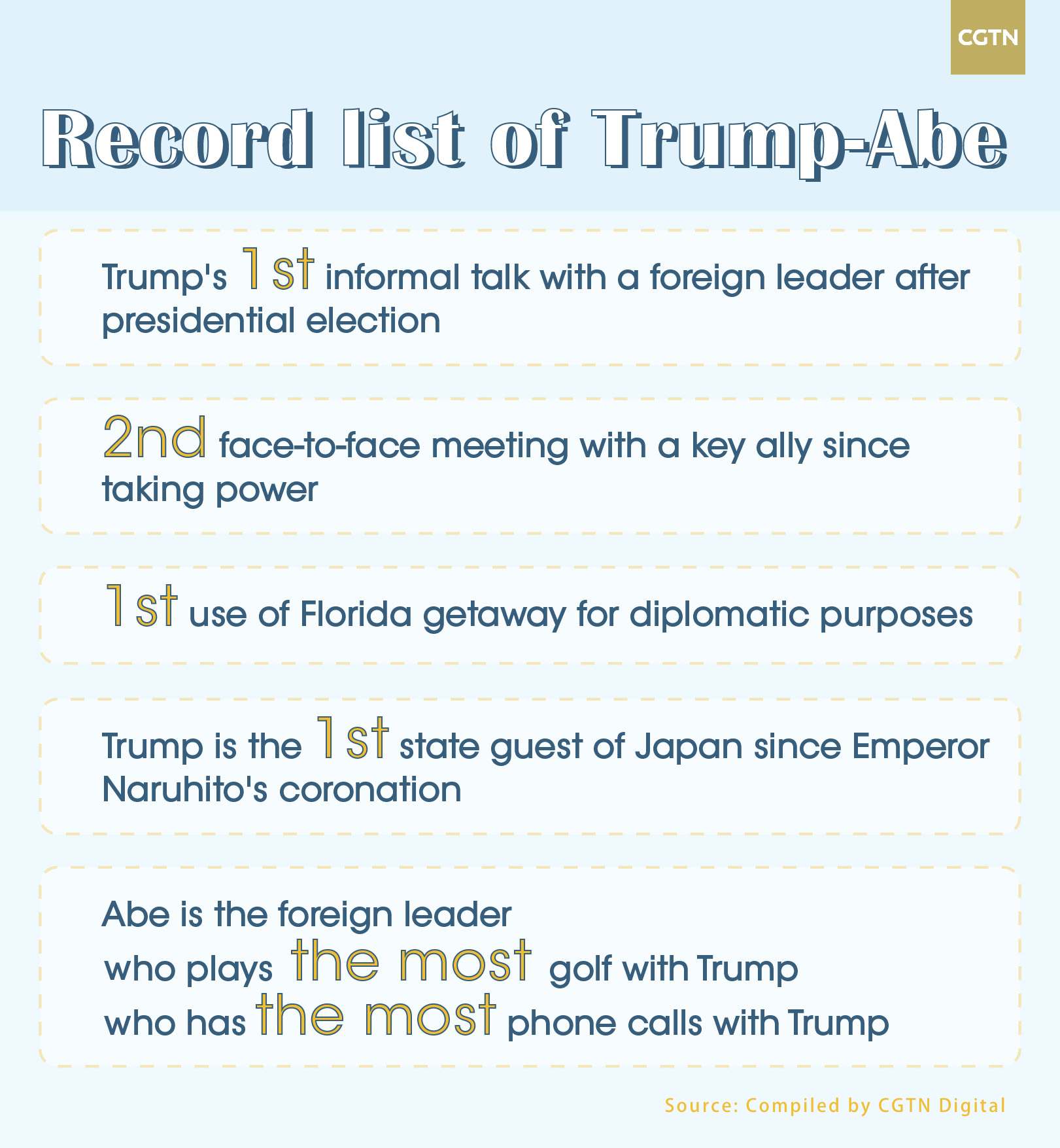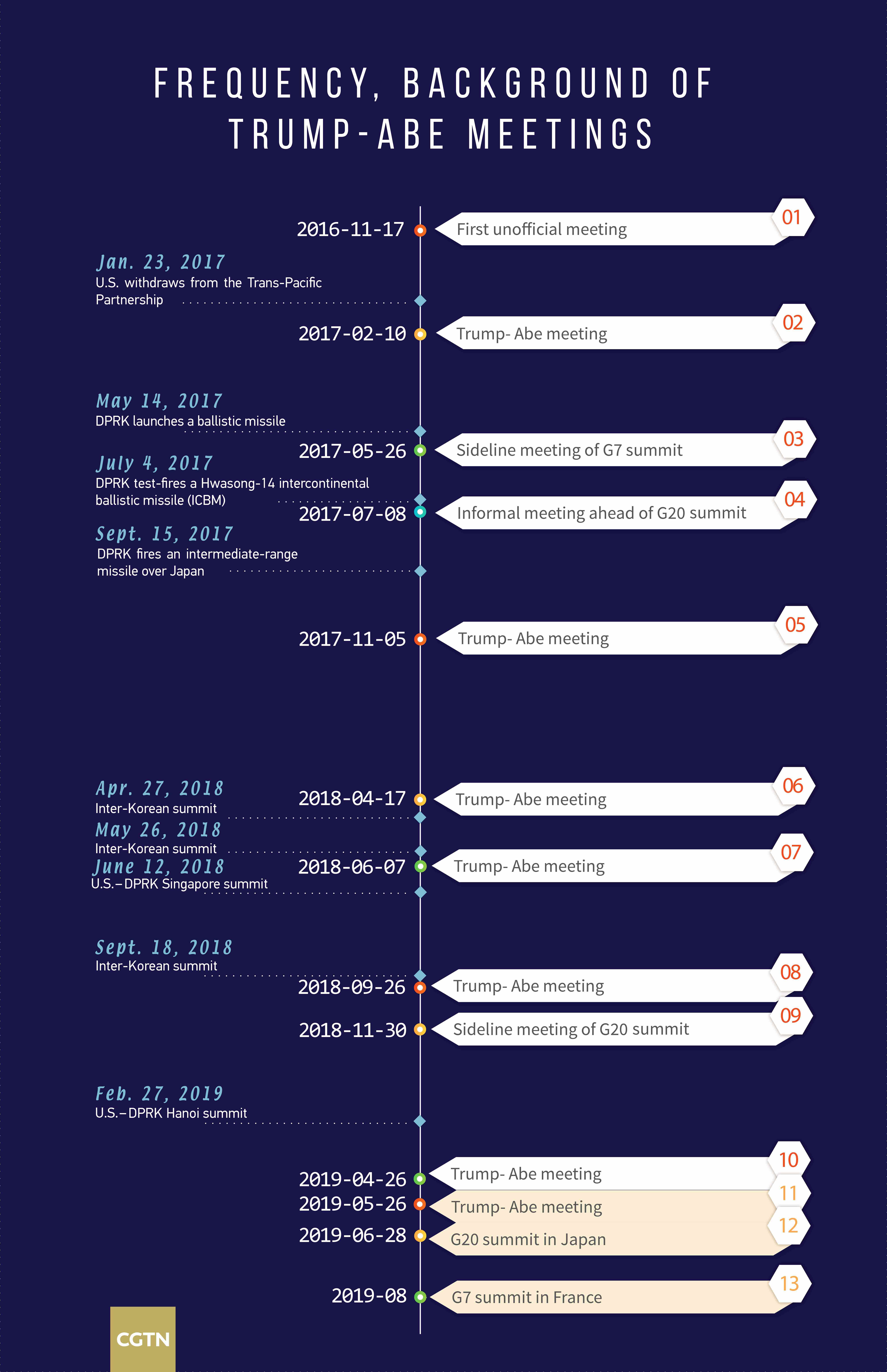
World
08:37, 24-May-2019
Trump, Abe: How to keep 'honeymoon' phase going?
Updated
12:52, 24-May-2019
By Duan Fengyuan

The relationship between the two leaders of the United States and Japan is a good example of the belief: Love is never enough to sustain a relationship, and bitterness is also needed to give it a balance.
How does this work?
U.S. President Donald Trump's four-day "date," starting Saturday, with Japanese Prime Minister Shinzo Abe in Japan gives us another chance to learn the art of relationship maintenance.
Trump's schedule for May 25-28 'date' (as Nikkei reported):
Day 1: Arrival, meeting with business staffs
Day 2: Playing golf, attending the Summer Grand Sumo Tournament and presenting trophy to the winner, and later having dinner at a traditional Japanese charcoal grill restaurant
Day 3: Meeting Japan's newly enthroned Emperor Naruhito, meeting with Abe, meeting with family members of Japanese nationals allegedly abducted by the DPRK, attending banquet at the imperial palace
Day 4: Inspecting Japan's Kaga helicopter carrier
These private, ceremonial and symbolic arrangements provide the Japanese media a reason to say: "Shinzo Abe, among all foreign leaders in the world, has the best relationship with Trump."

"What Prime Minister Abe has done was quite effective and you can even say strategic because, for Trump, personal chemistry is quite important," said Toshihiro Nakayama, a Japanese fellow at the Wilson Center in Washington.
A sweet, bitter love relationship under fire
During the last two years, Trump and Abe have met or spoken with each other more than 40 times, which also proves that forging close personal ties is a way to score diplomatic concessions.
Are the close private ties strong enough to really bind them together? The answer can be a "yes" if no conflict of interest exists, which definitely doesn't fit in the Trump-Abe case.
Looking back at the two leaders' first meeting, the answer becomes more obvious.
Nuclear issues of the Democratic People's Republic of Korea (DPRK), Indo-Pacific strategy and trade deficits have remained the top three topics, from the very beginning until now.

"Candid and warm" were the key adjectives for the two leaders' 90-minute meeting in 2016. Nevertheless, before the first handshake, the future of the alliance was not clear in the new U.S. president's remarks during his campaign.
On the contrary, negative signals were more obvious: Trump's concern of the possibility of Japan acquiring nuclear arms, his demand that allies pay more for keeping U.S. forces on their soil, and his opposition to the U.S.-led 12-nation Trans-Pacific Partnership (TPP) free trade pact. However, Abe's praises for Trump after the meeting ended all doubts.
After the good beginning, tests have always been with the relationship when the U.S. withdrew from the TPP and the DPRK made nuclear threats from time to time.
Trying to guarantee self-security and not irritating the DPRK, the Japanese prime minister has made efforts to communicate better with his ally, before and after interactions among the three parties – the DPRK, the Republic of Korea (ROK), and the United States.

Severer or softer sanctions on the DPRK, and how much are Washington and Tokyo willing to compromise on their trade relations? The two allies have been coordinating their strategical rhythm in the Asia-Pacific region accordingly.
A happy future ahead?
All is going well as quarrels are common among best friends. There is a trend that the relationship will develop faster with frequent meetings and that had never happened between the U.S. and Japanese leaders – three meetings between Trump and Abe in three consecutive months.
However, the two leaders are unlikely to issue a joint statement when they meet in Tokyo on Saturday to avoid exposing differing views on bilateral trade and the DPRK issues, Japanese government sources said ahead of Trump's visit.
A joint news conference after their talks will showcase the "strong relationship of trust" between Abe and Trump instead, as media reported.
This time, what more exchanges can they conduct to achieve a happily ever after?
(With inputs from agencies)
2104km

SITEMAP
Copyright © 2018 CGTN. Beijing ICP prepared NO.16065310-3
Copyright © 2018 CGTN. Beijing ICP prepared NO.16065310-3